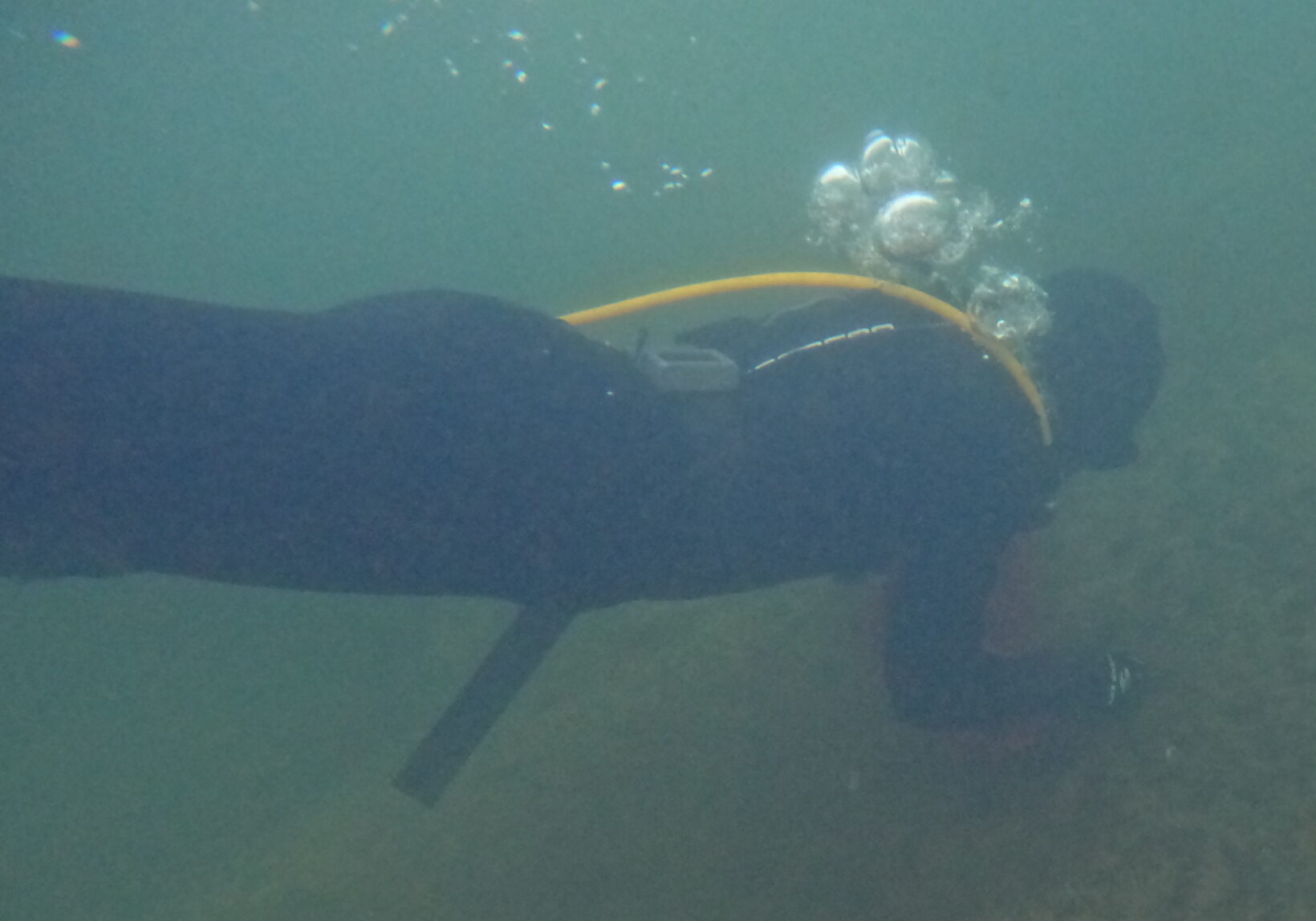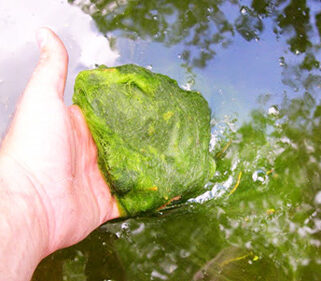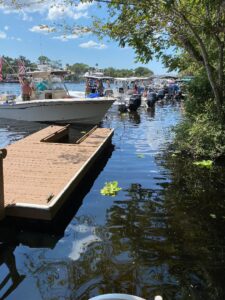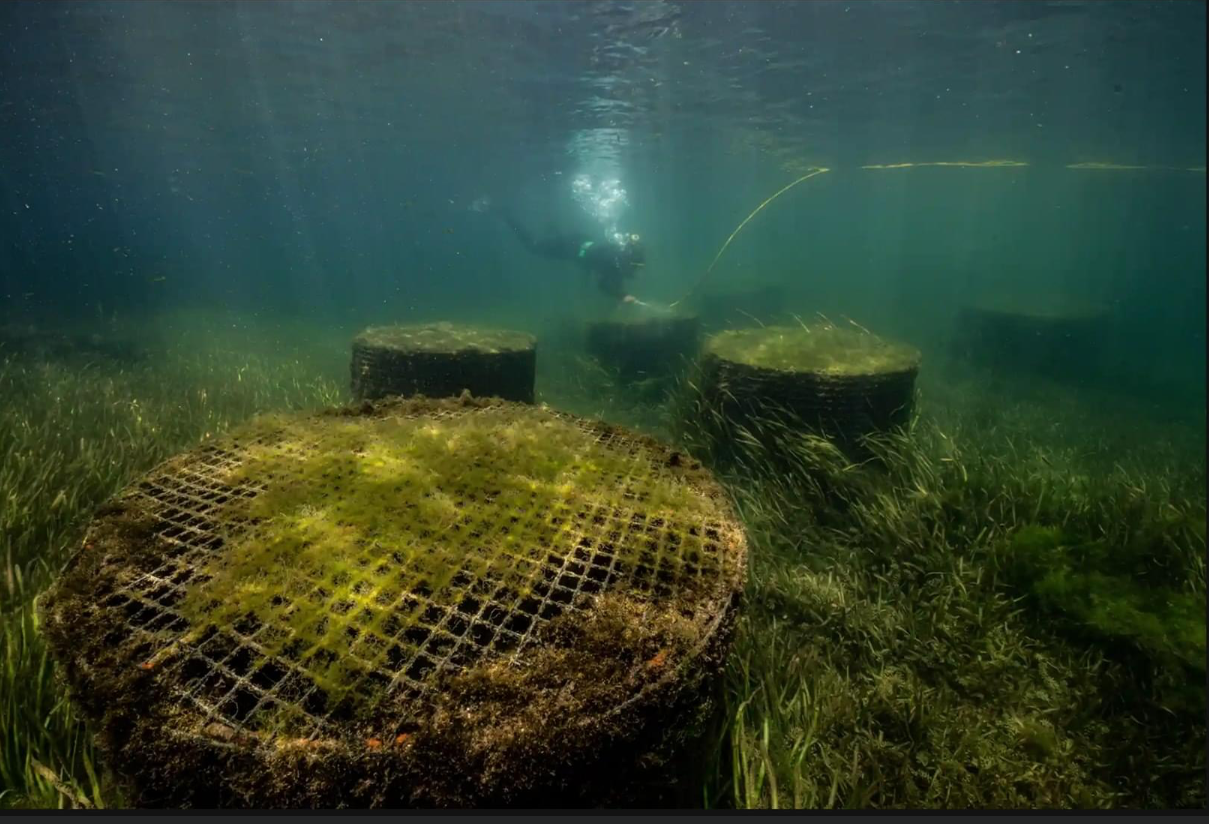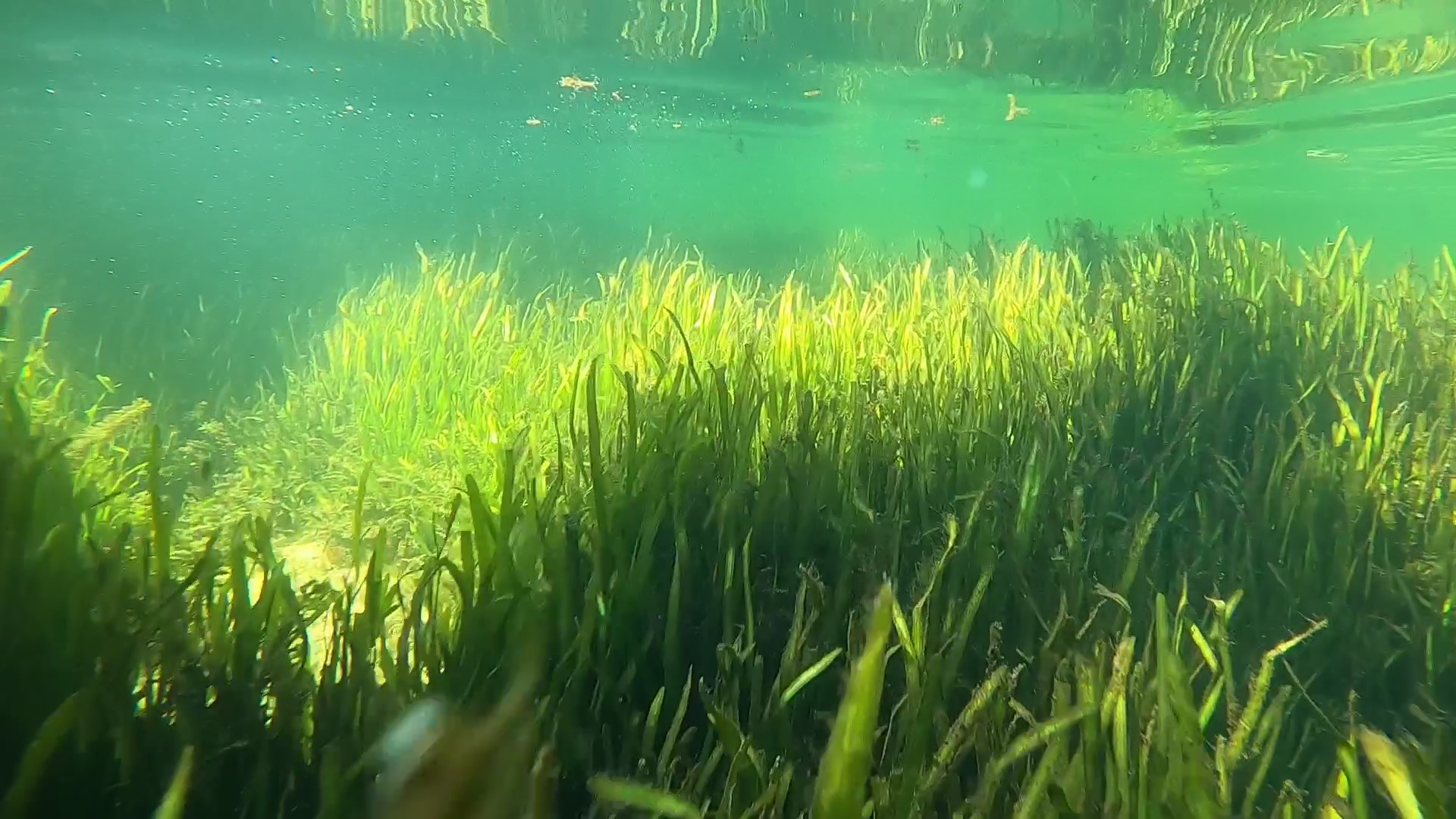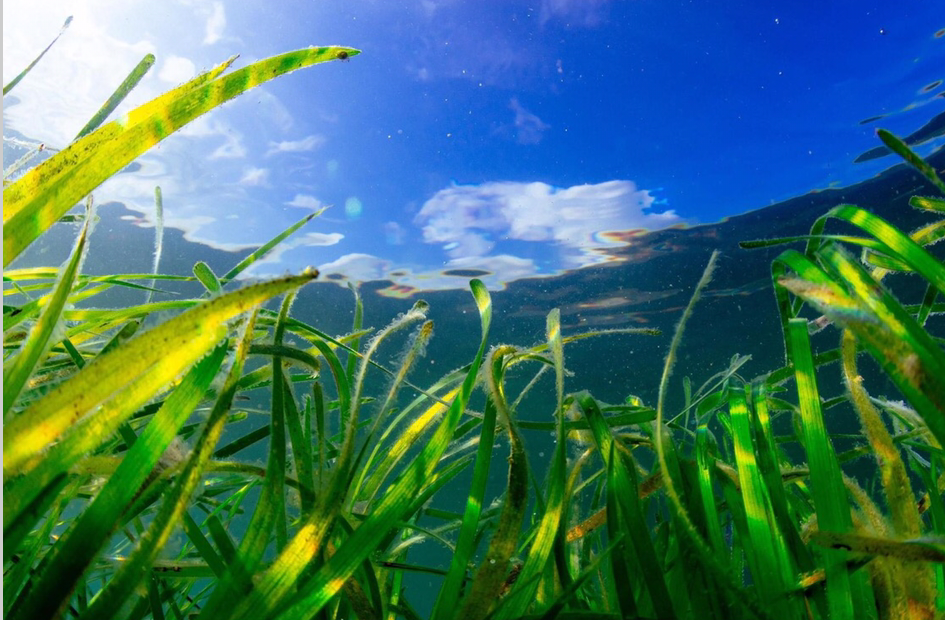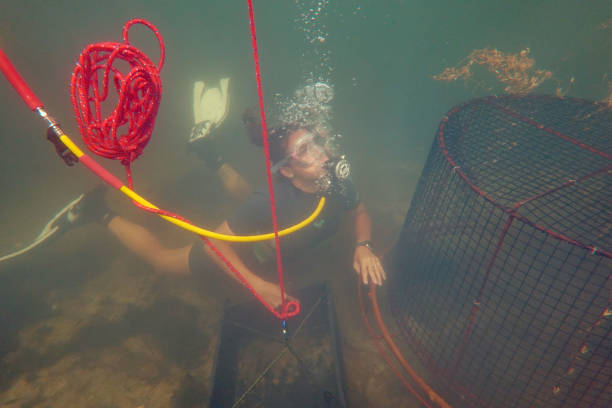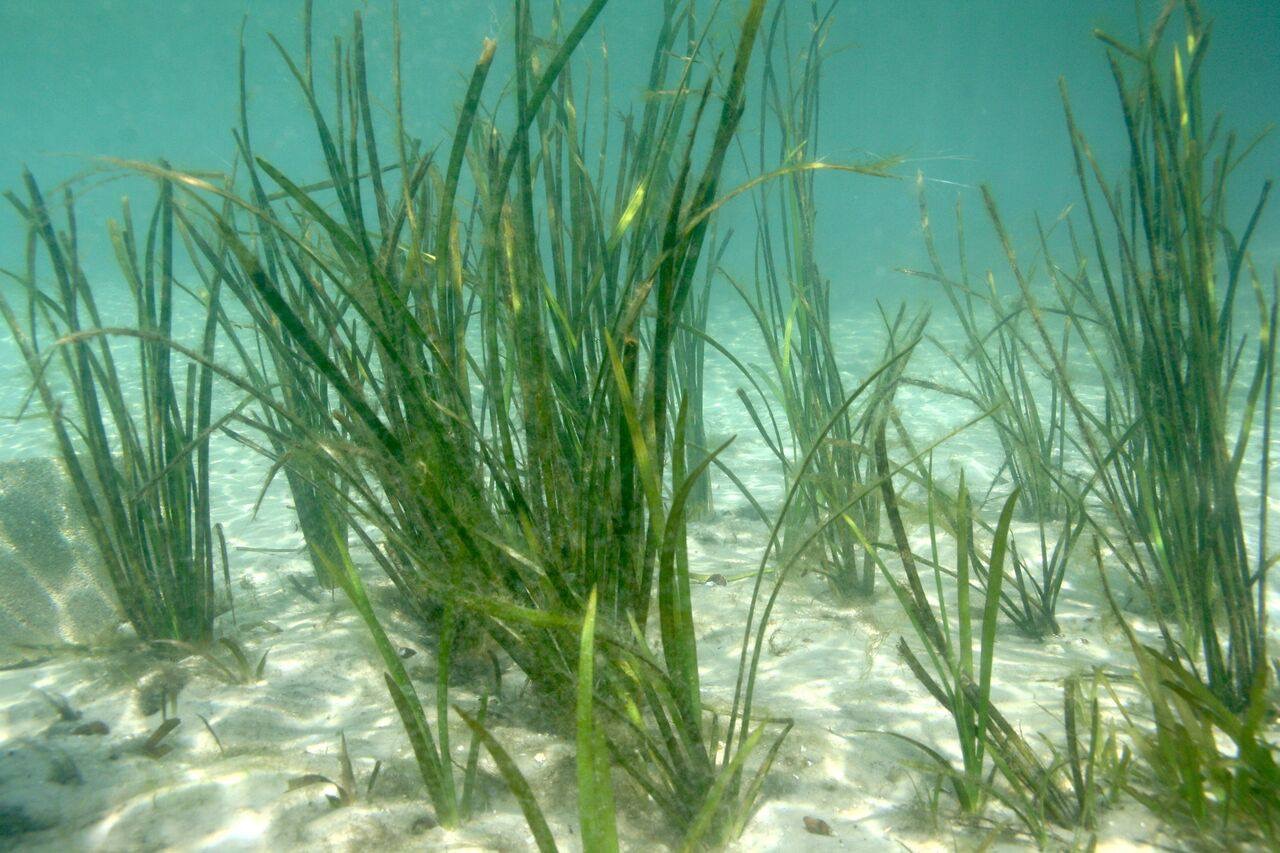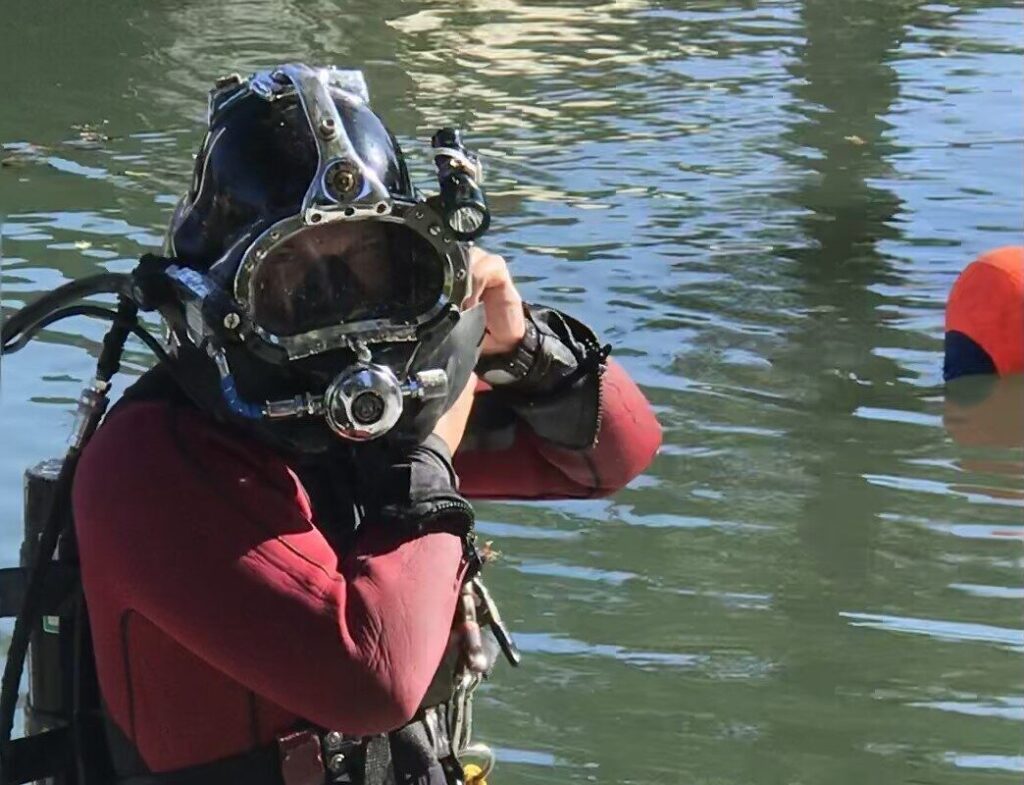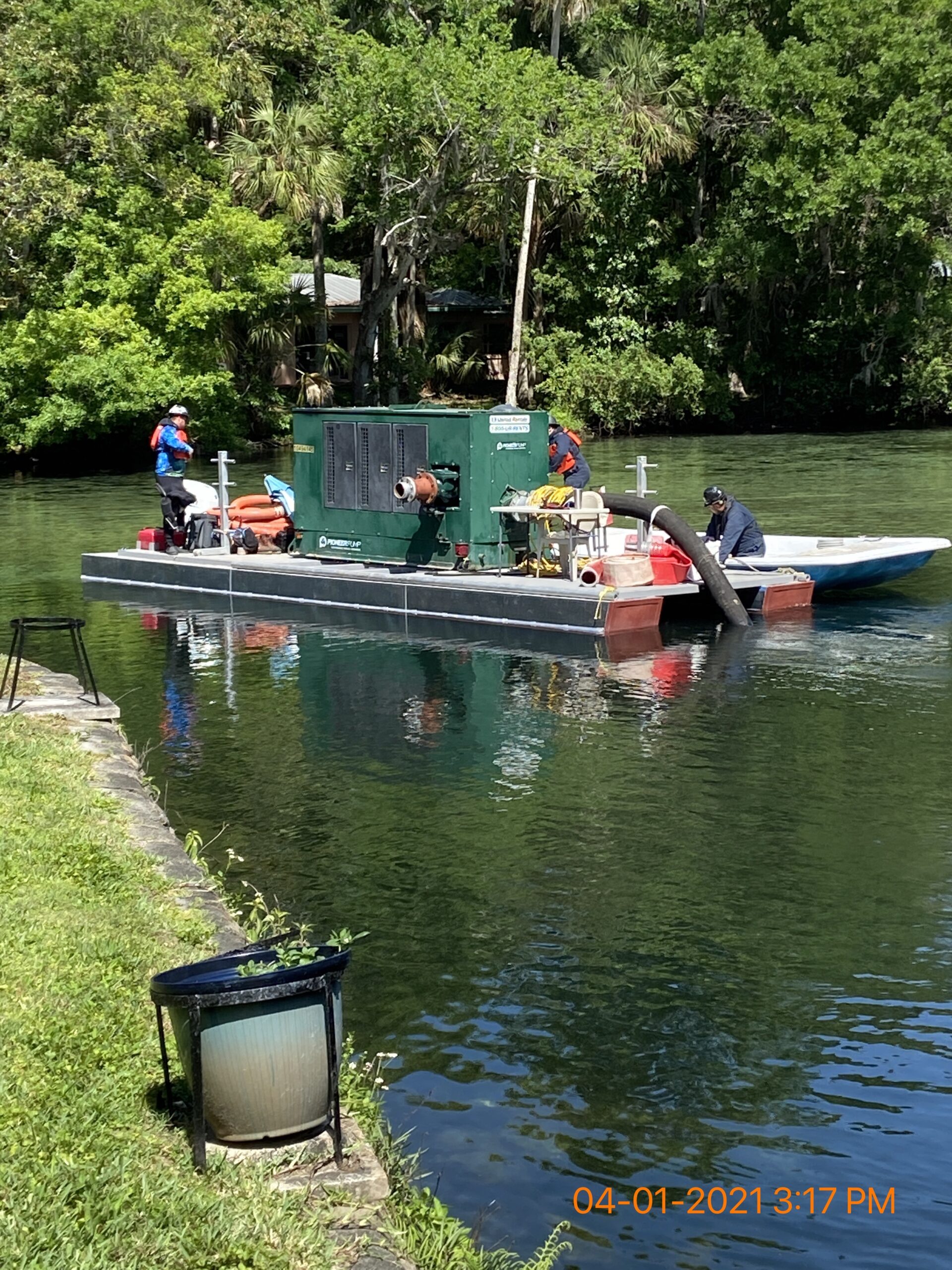2024 YEAR END REPORT
ANOTHER TOUGH YEAR

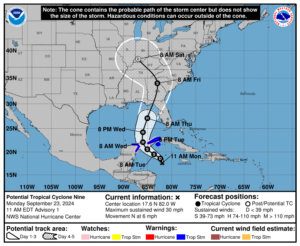 August 2023 brought Hurricane Idalia to our doorstep. In 2024 Hurricane Debbie followed several weeks later by Hurricane Helene once again bringing flood waters and heavy salt water intrusion to the Homosassa River. In both years many of the grass units that had been planted in the spring were to young to survive the increase in salinity. Storms, coupled with severe algae blooms, have combined to make an already difficult project even more of a challenge. Forcing an entire ecosystem to change from algae dominate to grass dominate was always going to be difficult. Curve balls from Mother Nature has not made the restoration efforts any easier.
August 2023 brought Hurricane Idalia to our doorstep. In 2024 Hurricane Debbie followed several weeks later by Hurricane Helene once again bringing flood waters and heavy salt water intrusion to the Homosassa River. In both years many of the grass units that had been planted in the spring were to young to survive the increase in salinity. Storms, coupled with severe algae blooms, have combined to make an already difficult project even more of a challenge. Forcing an entire ecosystem to change from algae dominate to grass dominate was always going to be difficult. Curve balls from Mother Nature has not made the restoration efforts any easier.
2024 ACHIEVEMENTS
While the 2024 season was extremely challenging progress was made. Although there was some initial success the establishment of new and expansive grass beds has not progressed as quickly has originally planned. HRRP has, however, been successful in improving water quality in other areas. An additional 9.8 acres (Phase 2) have been vacuumed. Maintenance (re-cleaning) of the Blue Water Loop canal in Phase 1 was completed in August as well as 557 cages and 28,935 units of grass installed. To date thousands of pounds of nitrates and detrital material have been removed from the river improving water quality and clarity.

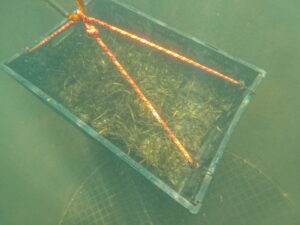
But the change that should make the largest difference moving forward occurred in late December. After 3 years HRRP finally obtained the necessary changes in our DEP, Army Corp and FWC permits to allow for full time winter work. Being unable to work from November 15th through April 1 of each year has severely impacted our ability to push the project forward.
GOALS FOR 2025
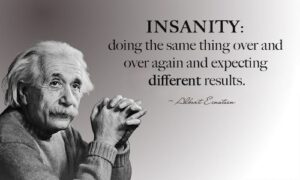 Restoring a river degraded over decades was always going to be a challenge. The best plans and ideas are often found to be ineffective, unattainable, or just plain wrong. Giving up is unacceptable but in order for success to be achieved HRRP has had to adapt. While growing grass upstream of the Fishbowl Drive bridge may still be feasible in some areas, the hundreds of people who insist on walking and standing on the river bottom during most days of the summer growing months will almost certainly doom our efforts. Exclusion cages used to protect young grasses were moved, stolen or severely damaged by the large number of boats anchored near the park just downstream of the bridge. At this time recreational activities within the upper Blue Waters of the Homosassa River will continue to hamper expanding the grass beds. This has forced HRRP to alter the project and the majority of grass growing efforts have been moved further downstream into Phase 2 and later into Phase 3. An additional 15,000 units of grass will be installed during February and March 2025 within Phase 2 and possibly the Blue Water Loop canal in Phase 1.
Restoring a river degraded over decades was always going to be a challenge. The best plans and ideas are often found to be ineffective, unattainable, or just plain wrong. Giving up is unacceptable but in order for success to be achieved HRRP has had to adapt. While growing grass upstream of the Fishbowl Drive bridge may still be feasible in some areas, the hundreds of people who insist on walking and standing on the river bottom during most days of the summer growing months will almost certainly doom our efforts. Exclusion cages used to protect young grasses were moved, stolen or severely damaged by the large number of boats anchored near the park just downstream of the bridge. At this time recreational activities within the upper Blue Waters of the Homosassa River will continue to hamper expanding the grass beds. This has forced HRRP to alter the project and the majority of grass growing efforts have been moved further downstream into Phase 2 and later into Phase 3. An additional 15,000 units of grass will be installed during February and March 2025 within Phase 2 and possibly the Blue Water Loop canal in Phase 1.
The 2025 Legislative year has begun and representatives from HRRP will be in Tallahassee in March to lobby and fight for the funding needed to continue the restoration efforts. We will hopefully meet with our new Florida House Representative J.J. Grow as well as our district Senator Blaise Ingoglia and DEP Deputy Secretary Adam Blalock to advocate the importance of a clean and healthy Homosassa River for both the citizens and economy of Citrus County.
YOU CAN HELP
- Please boat responsibility.
- Pay attention to where and how you anchor.
- Float don’t stand.
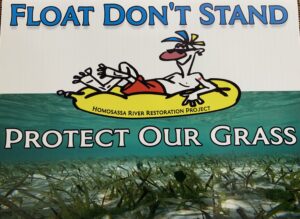
- Go to the Homosassa River Restoration Project website and learn more.
- Donate
- 2025 Crumps Pirate Invasion. Half of this years proceeds will benefit the restoration project. Please consider Sponsoring, volunteering for the event, or just getting your pirate on and attending a fun night benefiting the Homosassa community.
- Follow us on Facebook
NO ONE SAID IT WAS GOING TO BE EASY
Homosassa River Restoration Project Moves Ahead.
Restoration is complicated. An ecosystem severely degraded for decades will not heal quickly. Timelines and benchmarks can be set but nature has it’s own plans. Hurricanes, uncaring and uninformed boaters along with algae blooms hinder or destroy new grass beds. Equipment, permitting and funding issues are a constant challenge. Yet the project moves forward.
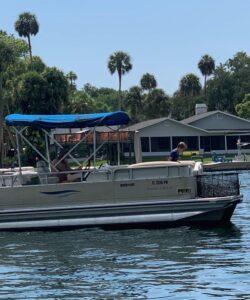 Fighting to grow and sustain grass
Fighting to grow and sustain grass
The installation of Submerged Aquatic Vegetation (SAV) in Phase 1 was an initial success. Unfortunately several factors soon turned that into less than satisfactory results. Large numbers or people walking and standing on the new grass upstream of the Fishbowl Drive Bridge soon uprooted and destroyed many areas. Exclusion cages in the main river channels were unknowingly caught on boaters anchors and some were just out and out vandalized. Many just disappeared altogether. Winter manatee season regulations did not allow for maintenance and cleaning of the cages that remained which allowed algae to build up and smother the healthy grass underneath. Yet HRRP continued to replant and slowly expand several grass beds. Then Hurricane Idalia paid the area a visit. Established grass which had managed to survive people, boaters and algae mostly survived the intrusion of salt water although damage was extensive. Grass which had just been installed earlier that season was too young to withstand the high salinity.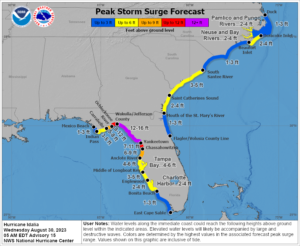
Goals for the 2024 Season.
Permit modifications have now been obtained that will allow divers to perform maintenance into the winter manatee season. Maintenance and recleaning and replanting of Phase 1 was delayed due to worksite issues but will finally begin the first week of July. Crews will concentrate on the Blue Water Loop Canal. Boaters do not usually anchor or stand in the canal leading to less pressure on newly planted grass. Initial vacuuming and planting in the canals located in Phase 2 will continue throughout the summer moving into the main river channel in late August and early September.
Thanks to the efforts of Senator Blaise Ingoglia and Representative Ralph Massullo during this years legislative session HRRP funding is secure for this year.
Long Term
The Save Crystal River Kings Bay Restoration Project and our own early success has proven that sustainable grass beds can be reintroduced in the Homosassa River. Working with our contractor, HRRP will continue to learn and adapt. New and innovative technologies are always coming online. Thanks to our state legislature and local fund raising initiatives, HRRP is completely funded for this year and remains committed to a successful restoration.
YOU CAN HELP
- Float Don’t Stand. It is no different than your front yard. If every weekend you have 100 of your friends parking and standing on your grass you will not have grass for long.
- Anchor Responsibly. Pay attention to where and how you anchor. Use a power pole or spud pole if possible. If you must use a Danforth type anchor do not drag it.
- Boat Responsibly. Know your boats draft. Trim up the motor when in shallow water or better yet just don’t go there.
- Check Out These Websites. Learn more about the efforts to save our natural resources. Save Crystal River. Sea & Shoreline.
- Donate. Help HRRP help the Homosassa River
- Follow us on social media. Like us on Facebook
Mid 2023 River Restoration Update
JULY 2023 HOMOSASSA RIVER RESTORATION OVERVIEW.
Restoration efforts on the Homosassa River began in the fall of 2020. Phase 1, approximately 25 acres, has been dredged of Lyngbya and detrital material and thousands of eelgrass plants installed. Maintenance of Phase 1 is ongoing. Phases 2 and 3 which will complete the restoration of the “Bluewaters” (headwaters to the confluence of the Halls River) section is currently on hold awaiting permits. Due to the efforts of Senator Blaise Ingoglia and Representative Ralph Massullo funding is in place to complete all of Phase 2 and begin Phase 3.
PERMITTING:
It has been 2 years and 4 months since Homosassa River Restoration Project Inc. applied for the Army Corps permit for Phases 2 and 3. After numerous phone calls, emails, and even after some much appreciated assistance from Congressman Gus Bilirakis, we are still waiting. HRRP has had the necessary Department of Environmental permit for approximately 18 months but must have both the DEP and Army Corps permits to move forward. There is hope that the permit will be granted by mid August giving the contractor, Sea & Shoreline, only 2 months of working time left before the project must be shut down for the winter manatee season.
A restoration project of this type is always a two steps forward and 1 step back approach. The algae does not want to give up its dominance and allow the grass to grow and flourish. Without the proper permits and unable to continue the restoration project downstream from Phase 1 our progress has slowed and allowed the algae to outcompete the grass.
Speaking of Algae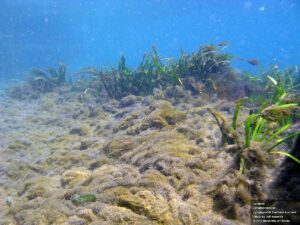
Besides Lyngbya algae there is also an algae called Chaetomorpha. It is an algae that has been documented in the Homosassa River since the early 90’s and can cover up to 80% of the river in many areas. One reason the algae is out of control is that Homosassa River does not have a primary producer, i.e. eelgrass. Primary producers are the basis of the food chain and are critical to the health of the ecosystem. Currently, algae uptakes nutrients and grows out of control because it has no competition. With the establishment of a primary producer, in our case eelgrass, HRRP will begin to combat the algae naturally. Eelgrass beds absorb excess nutrients, increase oxygen levels and stabilize the river bottom. All leading to a healthier system and fewer algae blooms.
Until we can tip the balance from an algae dominated system to a plant dominated system HRRP and Sea & Shoreline will continue working together to address the algae blooms through mechanical maintenance. The barge currently on the river has a crew of experienced divers vacuuming the algae out of the river by hand, targeting the areas that have dense algae accumulation. This process will allow young eelgrass plants to regain access to sunlight so they can continue to grow and establish in these areas.
So what about the Grass?
Growth and establishment of Submerged Aquatic Vegetation (SAV) takes time. Much like the perennials in your yard and garden, they follow a similar pattern; SLEEP, CREEP, them LEAP!
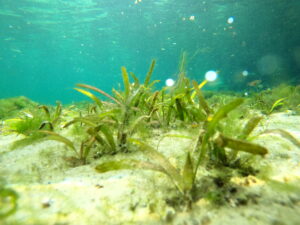
When SAV is first planted it may not look like it is doing much from the surface but there is a lot going on underground. Many plants spend the first year or two utilizing their energy on generating a healthy root system. That is the basis for strong and healthy plants.
The grass then begins to CREEP.
Once a healthy root system is established they begin to create new plants.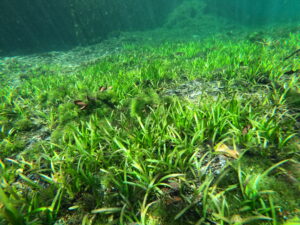 Again, it may not look like much from the surface, but if you take a closer look, you will see many new young plants breaking through along the river bottom. Eelgrass has rhizomes which enable them to create new plants right from the original parent plant. These new plants then extend their own rhizomes and the process continues.
Again, it may not look like much from the surface, but if you take a closer look, you will see many new young plants breaking through along the river bottom. Eelgrass has rhizomes which enable them to create new plants right from the original parent plant. These new plants then extend their own rhizomes and the process continues.
Finally they LEAP.
When the plants have established strong healthy root systems and denser coverage we will begin to see a noticeable difference. Fighting back against the algae that now controls the waterway. Long blades and flowers reaching to the surface of the water. Beds of grass waving in the currents.
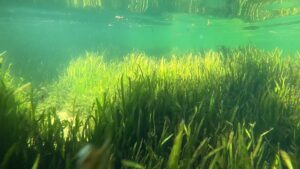
What’s Next?
Well that depends. If Army Corps releases the permit in the next week or two Sea & Shoreline divers will begin restoration in Phase 2 within a few days and will work right up until our winter deadline which is November 15, 2023. At this time no winter work is allowed. HRRP must also secure the funding necessary to complete Phase 3. Maintenance of all areas will continue into 2024 as well.
What Can You Do To Help
- Continue to spread the message of “Float Don’t Stand”.
- Do not anchor in eelgrass beds or on top of exclusion cages.
- Practice responsible anchoring. Do not drag your anchor or better yet use a pole anchor.
- Raise your prop when in shallow water.
- Like us on Facebook and follow our progress.
- Donate. Help us continue moving the restoration project downriver.

Farming Restoration Eelgrass
Farm Raised Eelgrass
So just where does the Homosassa River Restoration Project (HRRP) get all of the grass it plants in our river? And what type of grass are you planting anyways? Well glad you asked. Just as your neighbor would not appreciate you taking all of their sod from their yard to put into yours our project does not take grass from some other perfectly healthy ecosystem just so we can have some here. HRRP prefers to purchase farm raised grass.
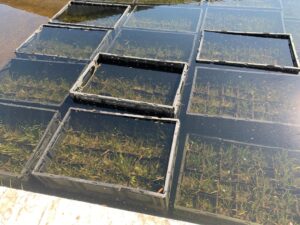
 Our contractor, Sea & Shoreline, grows all of the grasses installed here in Homosassa at a farm in Ruskin FL. By growing the grasses themselves they have better control over growth rates, preparation for planting, species type, and even the sex of the plant. Yes grasses are male or female.
Our contractor, Sea & Shoreline, grows all of the grasses installed here in Homosassa at a farm in Ruskin FL. By growing the grasses themselves they have better control over growth rates, preparation for planting, species type, and even the sex of the plant. Yes grasses are male or female.
What Type of Grass?
In this section of the Homosassa River HRRP is planting the species of eelgrass Vallisneria americana, There are two different types called “Rockstar” and “Salty Dog”. As the name implies, “Salty Dog” has a higher tolerance for increased levels of salinity. Vallisneria americana is often used in aquariums but is native to Florida and found in waters throughout the state. It forms strong underground runners which helps it spread and protects it from being uprooted by hungry manatees.
From Farm to River
When grasses on the farm are large enough they are either individually placed into pods or placed in four-inch (4”) Peat Pot planting units.
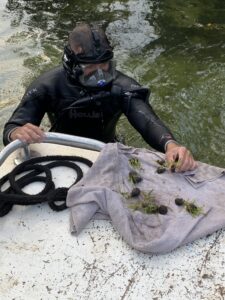
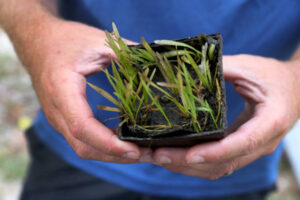
From harvesting and preparation on the farm to installation on the river bottom by divers, all of this work is painstakingly done by hand. It is time consuming and expensive but the success of the restoration project depends upon the growth and survival of healthy eelgrass meadows.
The Homosassa River had suffered a 90% loss of plant based vegetation which had been replaced by Lyngbya Algae. When the restoration project began there were no grass beds in this area.
Below is how the river bottom appeared in Phase 1 during initial cleaning.
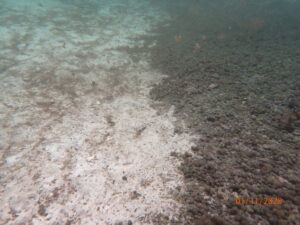
This is the same area 2 years after the initial planting in Phase 1.
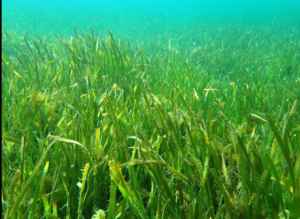
Check us out on Facebook.
The success of this program depends on people like YOU! DONATE if you can and help the Homosassa River.
2021 HOMOSASSA RIVER RESTORATION PROJECT YEAR END PROGRESS REPORT
FIRST FULL YEAR OF RESTORATION
Due to FWC regulations the beginning of winter manatee season marked the end the Homosassa River Restoration Projects’ first full season of in-water work. HRRP met or exceeded all of it’s 2021 goals. Thanks to our contractor, Sea & Shoreline, it has been a phenomenal year. Following is a quick compilation of what has been accomplished to date and goals for next year and beyond.
JUST THE FACTS
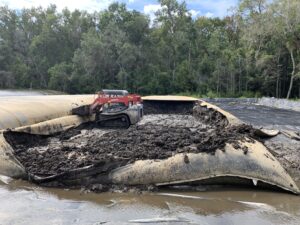
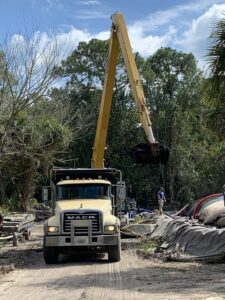
OVER 34,000 CUBIC YARDS OF MATERIAL REMOVED.
21 SPRING VENTS UNCLOGGED.
13.56 ACRES RESTORED
74,495 EELGRASS UNITS PLANTED
1,004 *GrowSAV Herbivory Exclusion Devices INSTALLED.
MAINTENANCE ALGAE REMOVAL started November 2021
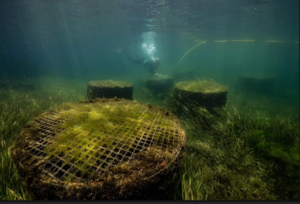
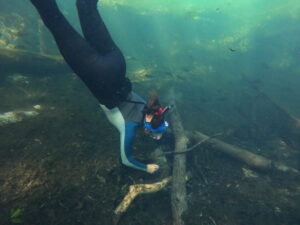
MOVING FORWARD IN 2022
RESTORE REMAINING 10.13 ACRES of PHASE 1
COMPLETE PERMITTING PHASES 2 & 3. 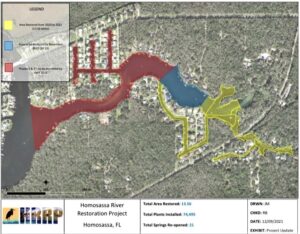
RESTORE AS MUCH OF PHASE 2 AS ALLOWED BY TIME AND FUNDING.
COUNTINUE MAINTENANCE OF RESTORED AREAS
HOMOSASSA RIVER RESTORATION PROJECT IS SUCCESSFULLY RESTORING EELGRASS MEADOWS
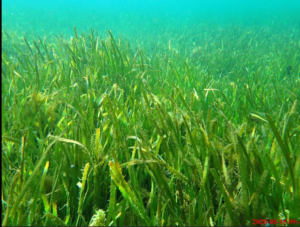 The Homosassa River Restoration Project is a multi year multi million dollar restoration project being completed by a small all volunteer 501(c)(3) in partnership with state agencies. Government/Private partnerships completing projects of this magnitude are extremely rare. HRRP would like to recognize the following:
The Homosassa River Restoration Project is a multi year multi million dollar restoration project being completed by a small all volunteer 501(c)(3) in partnership with state agencies. Government/Private partnerships completing projects of this magnitude are extremely rare. HRRP would like to recognize the following:
Save Crystal River 501(c)(3) for their vision, doing all of the initial heavy lifting and laying the groundwork for this successful endeavor.
Without the support and trust of our local legislators Senator Wilton Simpson and Representative Ralph Massullo these projects never would have seen the light of day.
The State Agency overseeing our project is The Florida Department of Environmental Protection and is responsible for and in overall control of the funding, contracts, and the oversite required to make sure that your taxpayer dollars are spent wisely and as intended.
THANK YOU HOMOSASSA!
Without the support of the community, projects such as ours, cannot become a reality. Hundreds of you trusted the board of HRRP to get this done. You donated, helped when you needed, and stood by us.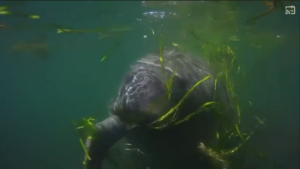
WHAT YOU CAN DO
- Watch out for exclusion cages. Look before anchoring. Tilt up during the shallow winter months.
- Continue to follow our progress on this website and LIKE US on Facebook.
- Happen to find yourself in front of Sen. Simpson and/or Rep. Ralph Massullo? Thank them for their past support and ask that they continue.
- Donate to HRRP
Growing River Grass
UNDERWATER GRASS FARMING
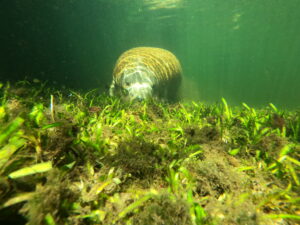
Reestablishing healthy vibrant underwater grass meadows. It is what the Homosassa River Restoration Project is all about. We cannot just truck in a load of sod and throw it on the bottom of the river. Biologists must plant thousands of units of eelgrass by hand. The Homosassa River Restoration Project does not take grass from other ecosystems. All grass installed here is grown by Sea & Shoreline in Ruskin Florida.
But to grow and thrive grasses need strong root systems to survive hungry herbivores. That is why we spend so much time, effort, and resources to first remove the thick layer of muck that currently covers the bottom of the river and canals. The loose organic material removed is a poor base for a strong root system.
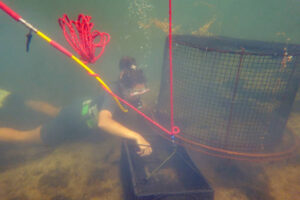
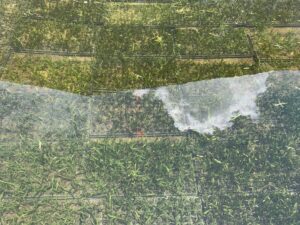 EXCLUSION CAGES
EXCLUSION CAGES
Hungry manatees, birds, turtles, and yes people, can easily dislodge the plants. When possible, exclusion cages are installed to protect young grasses.
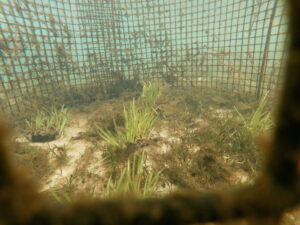
The minimum depth requirements for the installation of exclusion cages could not be met until recently. That limit, set by FWC, is 4 foot mean tide. Area’s “A”, “B”, and “C” were too shallow. Crews recently completed the cleaning of areas “D”, “E”, and “F” removing, in some cases, several feet of muck and detrital material. Biologists followed closely behind installing new grass along with exclusion cages. 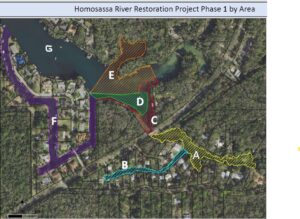
Why are the exclusion cages not marked by buoys or some other type of floating marker?
Sea & Shoreline is installing hundreds of exclusion cages during the restoration process. Many of them are within navigable channels and will remain on the bottom for at least 12 months. If all of the cages were marked it would pose a navigational nightmare.
How You Can Help
- When anchoring within the restored area’s please be on the lookout for exclusion cages.
- Please do not move or otherwise tamper with the cages.
- Go to the Homosassa River Restoration Project website to learn more.
- Donate
- Follow us on Facebook
GRASS GRASS GRASS
IT’S ALL ABOUT THE GRASS
It may be all about the grass but first a clean substrate is necessary to plant and that is why we vacuum dredge. Removing years of nutrient laden muck and detrital material exposing the sand and gravel base optimal for root growth. Grass is the key component of the Homosassa River Restoration Project. Grass cleans the water, stabilizes sediments, provides food and habitat for fish and animals, and helps remove harmful nutrients. Healthy grass beds will change an algae-dominated water body into a beautiful, clean, clear, sustainable plant based ecosystem.
Grass units planted last October are taking root and beginning to spread. Sea & Shoreline biologists concentrated on the main riverbed on the east side of the Fishbowl Drive Bridge (Area A) and we are seeing the rewards of their efforts. Despite the negative pressures of people and manatee’s lateral growth has been better than expected in a good portion of areas planted. Small colonies of grass have also started to migrate and root downstream as well.
In the spring of this year Area “B” was planted along with Area “C” in June. This past week Area “D” was planted and marked the beginning of the use of herbivore exclusion cages.
 In Area “D” alone there were 119 herbivory cages, 595 4″ potted plant units, and 6,215 mechanical plant units installed. To date biologists have installed 28,920 individual plant units in Area’s “A” through “D”
In Area “D” alone there were 119 herbivory cages, 595 4″ potted plant units, and 6,215 mechanical plant units installed. To date biologists have installed 28,920 individual plant units in Area’s “A” through “D”
EXCLUSION CAGES
What are they and why do we use them? Manatee’s eat grass. They eat a lot of grass and that includes ours. As long as the grass blades are chewed off near the bottom, similar to cattle grazing on a pasture, no problem. An issue arises if the grass root systems are not strong enough to keep the grass from being completely dislodged. People walking along the bottom can cause similar problems. Herbivory cages help protect young grasses until they are able to establish root systems strong enough to withstand a hungry manatee. FWC regulates when and how we can use underwater devices and until now there was insufficient water depth to use the cages. The cages are kept in place for 1 to 2 years and have to be cleaned regularly.

“BUT I JUST HAVEN’T NOTICED MUCH CHANGE”
It has taken many years of steady decline to reach where this river is today. Restoration projects of this magnitude do not occur overnight. The Homosassa River is still algae dominant but as the grass beds expand they will slowly drive out the Lyngbya. Floating mats of Lyngbya will, and have, moved back into area’s already cleaned and planted. It makes it hard to see the grass but it is there developing strong root systems and spreading out. Grasses have begun to develop some height as well. Maintenance of these previously cleaned and planted sections will begin soon. This periodic maintenance is important until the grasses gain a foothold over the Lyngbya.
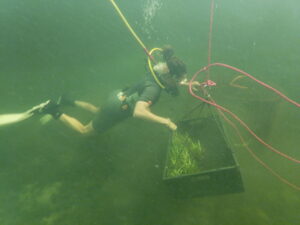
HOW YOU CAN HELP
Spread the word!! Anchors and props damage grasses. Try and watch where you stand if enjoying a day in the headwaters. Just like your lawn, aquatic grasses can be destroyed by too much foot traffic.
Continue to follow us on Facebook and this website. We keep expenses to a minimum but running an organization, even a volunteer one, has overhead. DONATE to our 501c3 if you can or we are listed with Amazon Smile which makes helping us easy and free to you if you are an Amazon shopper.
Restoration Progress Second Quarter 2021
RESTORATION PROGESS SECOND QUARTER 2021
Sea and Shoreline work crews moved rapidly to clean as much river bottom as possible in the area adjacent to the park as the second quarter of 2021 came to a close and before the madness of scallop season descended upon us. We were able to complete Areas C & D before the July 4th holiday. Unfortunately the part of Area E (where many of the boats anchor) is still being cleaned but we should be able to move within the safer confines of Mitten Cove within Area E by the end of next week. That area is very thick with muck and detrital material and it is expected that our square footage per day completion totals will drop accordingly.
As the busy scallop season begins our intent is to focus on the Blue Water Loop Canal (Area F) during most of July. Less boat traffic in the canal makes it easer and safer for divers to work underwater. Plans to deploy a second barge and crew were delayed but should be in place soon.
Turbidity curtains will often be in place while divers are working. It is possible to navigate your vessel over a turbidity curtain. Simply have the boat in forward motion and as you approach the curtain place in neutral and trim up your motor to clear the curtain. Kayaks and canoes can also pass over the curtains fairly easily.
!!! PLEASE LOOK OUT FOR DIVERS. IF YOU ARE UNSURE ASK THE SPOTTER ON THE BARGE BEFORE ENTERING THE AREA !!!
 WORKSITE
WORKSITE
Currently there are two Geo Tube filter bags in place and operational and a third will be added this week. The worksite, across Halls River Road form the entrance to Publix, will be in use though the Phase One permitted area.
PERMITTING
 Permitting for Phase Two is well underway and we expect to have permits from both Army Corp and Department of Environmental in our possession very soon. This second round of permits will allow Homosassa River Restoration Project Inc. to clean and restore up to the confluence of the Homosassa and Halls Rivers.
Permitting for Phase Two is well underway and we expect to have permits from both Army Corp and Department of Environmental in our possession very soon. This second round of permits will allow Homosassa River Restoration Project Inc. to clean and restore up to the confluence of the Homosassa and Halls Rivers.
GRASSES
Approximately 14,000 grass units have been installed in Sections “A” and “B”. Some areas that experience a lot of foot traffic are not doing well and are void of any grass. Those areas that people tend to stand on less frequently have had exponential growth and are doing even better than we expected. HRRP has suggested that our contractor wait until August to plant on the west side of Fishbowl Drive. At least where all the boats tend to congregate. Downside to that is we miss some great growing season time which is important to well established grasses before hungry manatees begin to show up in the cooler months. Final decision will be left up to the experts at Sea and Shoreline.
WHAT ABOUT YOU?
- Go to Homosassa River Restoration Project.com and learn more.
- IF YOU LIKE TO VISIT THE HEADSPRING AREA PLEASE FLOAT AND TRY NOT TO STAND ON GRASSES
- Follow us on Facebook.
- Tell others about what we doing. Ask them to help.
WEEK SIX 2021 UPDATE
SIX WEEK RESTORATION UPDATE
Homosassa River Restoration Project had divers back in the water April 1, 2021. The removal of Lyngbya, muck, and other detrital material is progressing smoothly though perhaps a bit slower than we had hoped. While cleaning the Spring Cove Canal (Area “B”) there were some issues with clay mixed in with the muck which made it difficult for both the divers and the worksite crews when it came to filtering and returning clean water to the river. These issues were resolved and the canal was finished last week. 
On Tuesday May 11th we were fortunate to have a tide low enough to move the barge and pump equipment under the Fishbowl Drive bridge. Operations are now underway directly in front of the Homosassa Springs State Park observation platform. You can see the barge as you drive over the bridge. This crew will be joined by a second barge and group of divers next week. The expectation is that Area’s “C” and “D” will be cleaned by early June 2021.
WHAT ABOUT THE GRASS?
As you already know our contractor, Sea & Shoreline, installed 11,000 grass pods just before ending operations November 1, 2020 for the winter manatee season. Yes there has been loss of grass. Mostly due to people standing and walking as well as damage from boat propellers. There are, however, areas that are thriving. The type of grass we are planting prefers to grow out laterally at first and staying short. As it gets thicker it will begin to compete with itself and start to get longer and taller. Our biologists are also finding grasses that have been covered by muck for years and dormant but the cleaning efforts have made conditions right and they are able to grow once again.
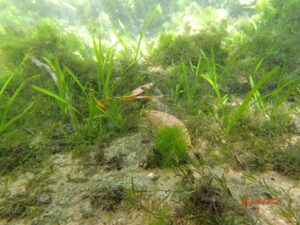
This will not be an overnight process. It has taken Save Crystal River several years to achieve the amount of grass meadows they now have. While HRRP believes we can make it happen quicker than that it will not be an easy task. The Lyngbya will not give up willingly. Manatee’s, turtles, fish all love to eat the grasses as well. It will be a struggle to get ahead of the curve but we will be successful. New grass planting will begin in Area “B” around May 15, 2021
MAINTENANCE
But why is there still some muck and Lyngbya in the already cleaned areas? Part of our contract with Sea & Shoreline is periodic maintenance of previously cleaned and planted areas. Keep in mind that this is a natural spring and river system and not Disney World. The divers, as hard as they try, will never get all of the bad stuff on the first clean. Tides, wind, and currents will always be working to move Lyngbya and debris back into completed areas. The key is to give the grasses a fighting chance to push out the Lyngbya and thrive on their own.
PERMITTING
All documentation has been filed with both the Department of Environmental Protection and Army Corp to permit the restoration process up to the confluence of the Homosassa River and the Halls River. The hope is that the process of securing the permits will move along much faster than last year.
SEA & SHORELINE CREW
The divers, biologists, and support personnel of Sea and Shoreline who joined us for a night off and a little food and fun These are the hard working folks helping us restore the Homosassa River.
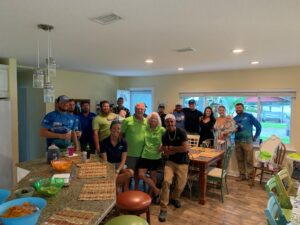
WHAT YOU CAN DO
- Follow our progress on Facebook and website
- Spread the word about what we are doing
- When possible educate others on how to protect this beautiful and fragile resource.
- Donate if you can.
- Let your local and state leaders know that additional protections in the form of local ordinances and legislation are necessary to protect this river for future generations to enjoy. You can email Senator Wilton Simpson at simpson.wilton@flsenate.gov and Representative Ralph Massullo at Ralph.Massullo@myfloridahouse.gov
Moving Forward in 2021
Winter Manatee Season Has Ended
FWC regulations do not allow In-water operations during manatee season and restoration has been at a standstill since the last day of October last year. Well perhaps not a complete standstill. Over 11,000 units of grass were planted before divers left the waters on the eastside of Fishbowl Bridge and those plants have been slowly taking root.

Yes we have had some losses due to manatees and also people standing and walking along the bottom but it is a start. Now, with the summer growing season almost here and hungry manatee’s off to the Gulf, we will begin to see noticeable changes. An assessment of how many grasses survived and their locations will be completed during the first few weeks.
Where Is The Project Now?
This map shows the river and canals that were first permitted, designated as Phase 1.  Before ending operations last fall we were able to complete Area “A”. Beginning immediately divers will be back in Area ‘B”. The plan is to then move into Area’s “C”, “D”, “E”, and “F” in that order. That order may have to change depending on the amount of boat traffic we experience. That would also use all of our current funding. Homosassa River Restoration Project has been working hard to secure the funds to continue and we are very optimistic that we will able to complete Area “G” this summer as well. That will finish the entire 25 acres first permitted.
Before ending operations last fall we were able to complete Area “A”. Beginning immediately divers will be back in Area ‘B”. The plan is to then move into Area’s “C”, “D”, “E”, and “F” in that order. That order may have to change depending on the amount of boat traffic we experience. That would also use all of our current funding. Homosassa River Restoration Project has been working hard to secure the funds to continue and we are very optimistic that we will able to complete Area “G” this summer as well. That will finish the entire 25 acres first permitted.
What’s Next You Ask.
Phases 2 and 3 will be covered under the second permit. As shown on the map this will bring the restoration project up to the confluence of the Homosassa and Halls Rivers. The expected timeline for completion of both phases is end of summer 2022 if enough funding is obtained. Total restored river and canals at this point would be a little over 46 acres. Remember that maintenance of the restored area will continue for an additional two years until grasses are established. 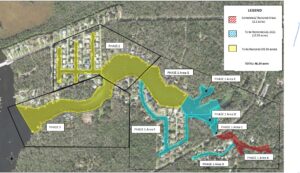
And Then?
Well to be honest that will depend on several factors. Some of them political in nature. Our main benefactor in the Florida Senate, Wilton Simpson, will be leaving office due to term limits. Senator Simpson has backed the Homosassa River Restoration Project as well as Save Crystal River and without his support neither group would have been successful. Representative Ralph Massullo has always supported our efforts on the House side and will remain in office. Funding for a restoration project of this size must be funded at the state level and it is our hope that our legislators continue to see the benefits of a clean and healthy Homosassa River.
How You Can Help
Spread the word!! Anchors and props damage grasses. Try and watch where you stand if enjoying a day in the headwaters. Just like your lawn, aquatic grasses can be destroyed by to much foot traffic.
If you are boating near a work area PLEASE watch out for divers. Keep in mind there may, and probably will, be more than one diver in the water.
Continue to follow us on Facebook and this website. We keep expenses to a minimum but running an organization, even a volunteer one, has overhead. DONATE to our 501c3 if you can or we are listed with Amazon Smile which makes helping us easy and free to you if you are an Amazon shopper.

